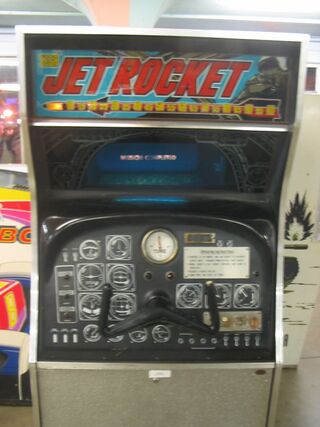Jet Rocket
From Sega Retro
| Jet Rocket | |||||
|---|---|---|---|---|---|
| System(s): Electro-mechanical | |||||
| Publisher: Sega | |||||
| Developer: Sega Production and Engineering Department | |||||
| Genre: Simulation | |||||
| Number of players: 1 | |||||
|
Jet Rocket is a 1970 electro-mechanical arcade flight simulator manufactured by Sega.
The player aircraft is viewed from a first-person perspective, and the landscape and targets are displayed on a screen, using a projection display system similar to Duck Hunt, Grand Prix, Missile and Killer Shark.
Contents
Specifications
- Height: 71.5"
- Width: 31.5"
- Length: 47.5"
Gameplay
Using controls which look like that of a cockpit, the player controls the jet by joystick handle and aims rockets to intercept target areas such as fuel dumps, missile sites, island fortresses and air strips in a night mission. Pushing the firing button fires the rocket. When a target is hit, the rocket explodes and score (5 points per hit) is indicated. Ground impact explosions are marked by light and sound effects.
The cockpit controls move the player aircraft around the 3D landscape displayed on a screen and shoot missiles onto targets that explode when hit.
Development and release
Sega Production and Engineering Department, led by Hisashi Suzuki, developed Jet Rocket in the late 1960s. Before its wide American release in August 1970, Sega had previously sent out prototypes for testing, after which it was cloned by three Chicago manufacturers.[1] The clones included Bally's Target Zero and Williams' Flotilla, both released in December 1970. This negatively affected the game's performance in America, and temporarily put a halt to Sega's export business, before recovering later.[2]
Legacy
It featured shooting and flight movement in a 3D environment from a first-person perspective, like first-person vehicle combat video games such as Battlezone (1980) and Hovertank 3D (1991). This makes Jet Rocket the earliest first-person shooter.[3]
The game had free-roaming flight movement over an open-ended 3D landscape, for the first time in an electronic game. This makes it the first primitive example of an open world game.
Promotional material
Physical scans
References
- ↑ File:NextGeneration US 24.pdf, page 11
- ↑ File:NextGeneration US 24.pdf, page 12
- ↑ [Carl Therrien, Inspecting Video Game Historiography Through Critical Lens: Etymology of the First-Person Shooter Genre, Game Studies: The International Journal of Computer Game Research, Volume 15, issue 2, December 2015, ISSN 1604-7982 Carl Therrien, Inspecting Video Game Historiography Through Critical Lens: Etymology of the First-Person Shooter Genre, Game Studies: The International Journal of Computer Game Research, Volume 15, issue 2, December 2015, ISSN 1604-7982]


